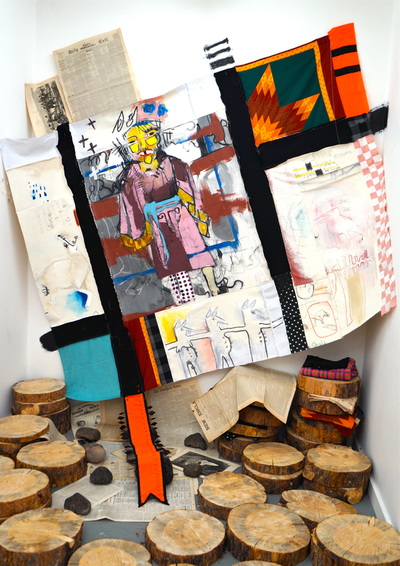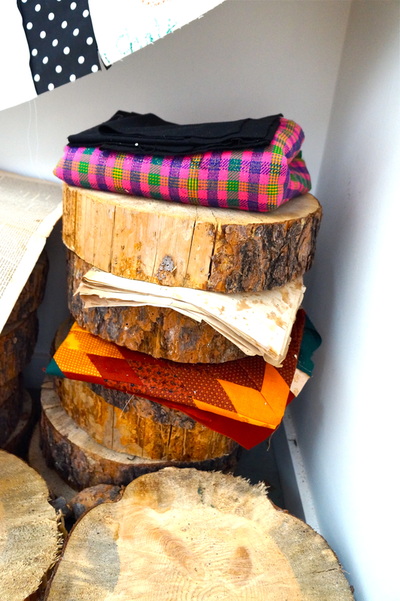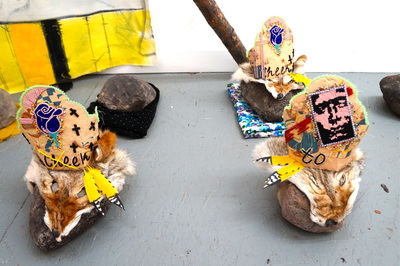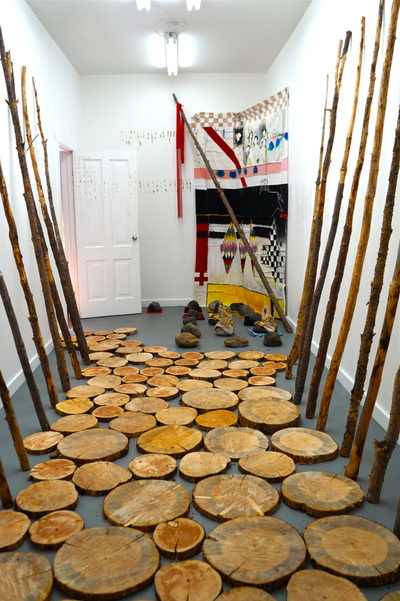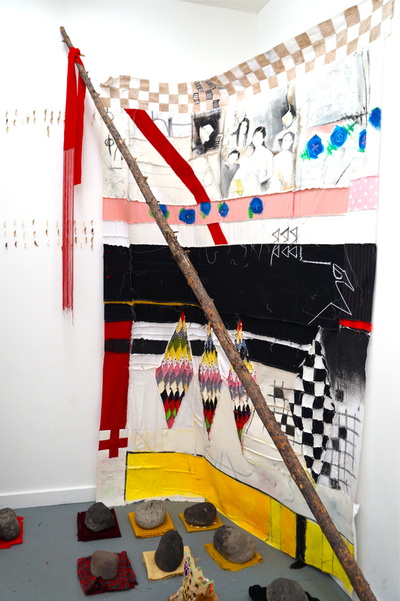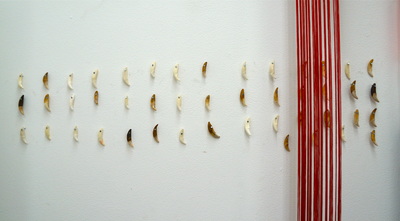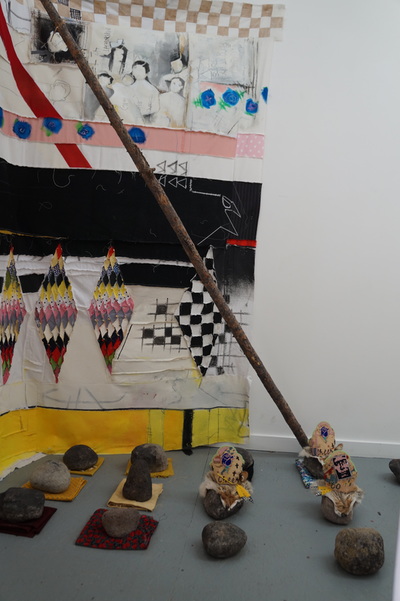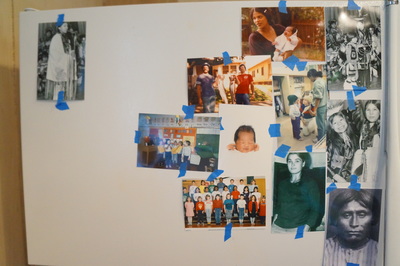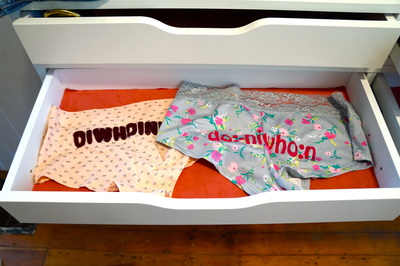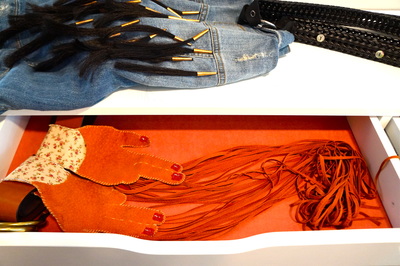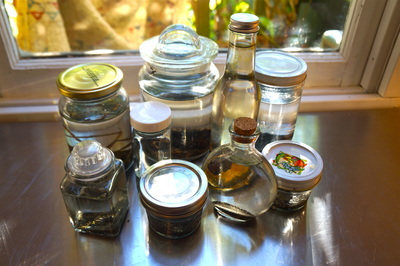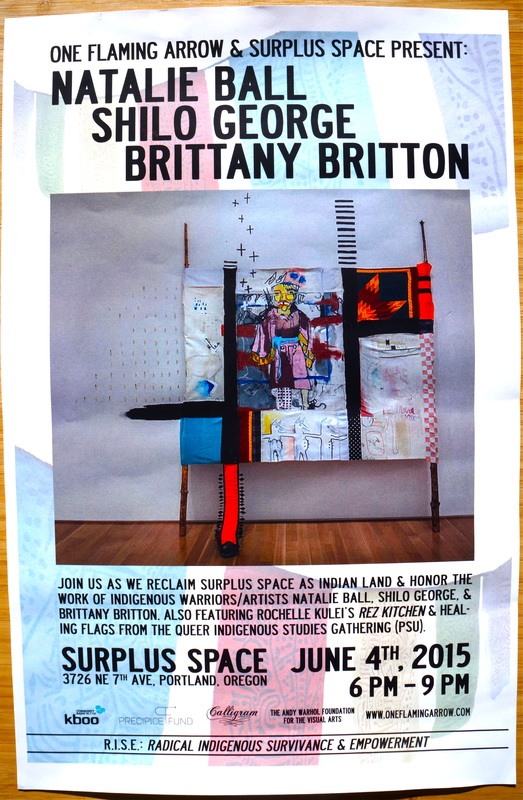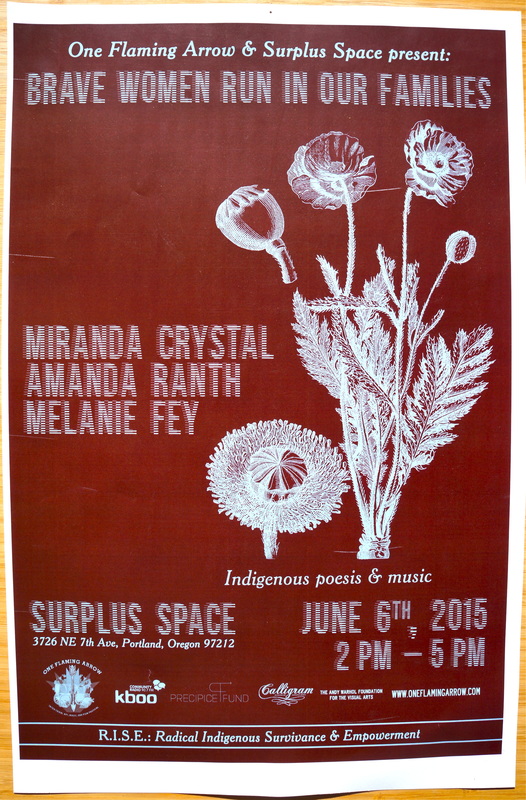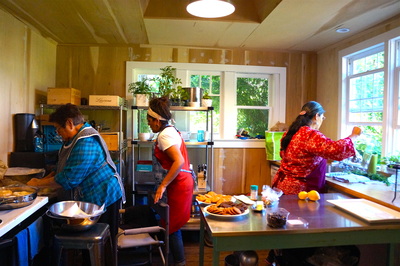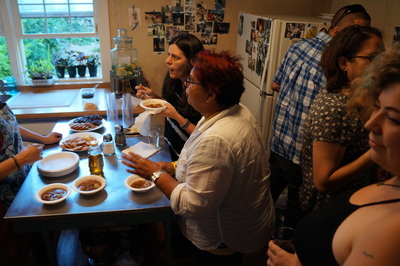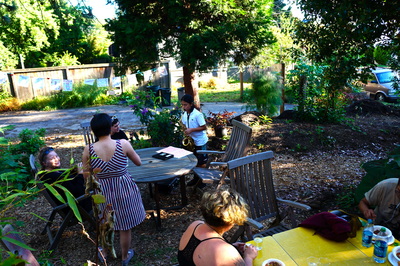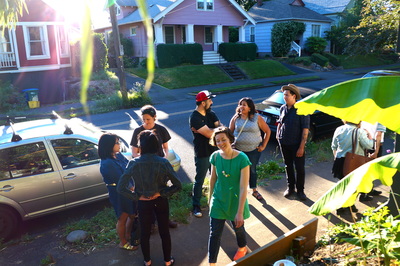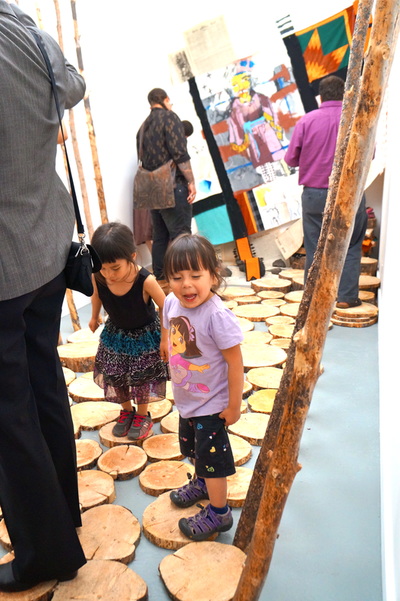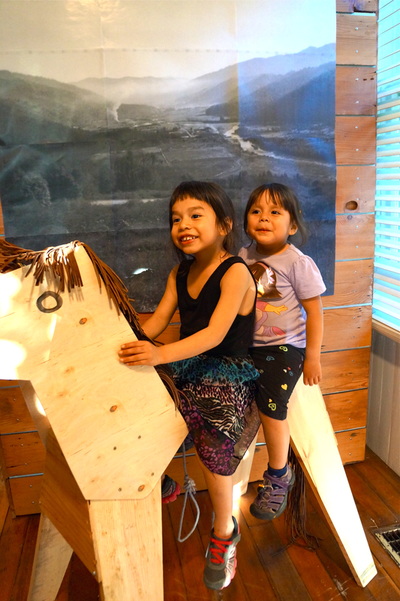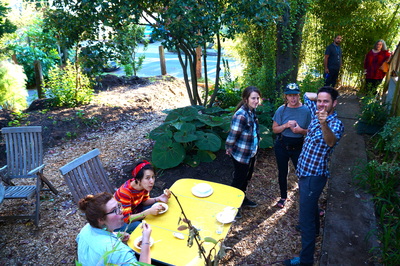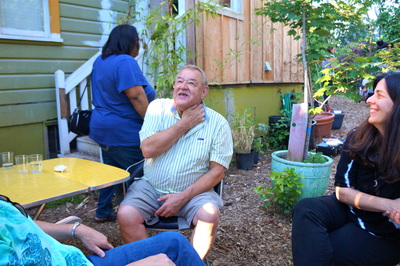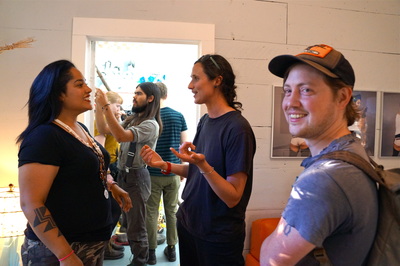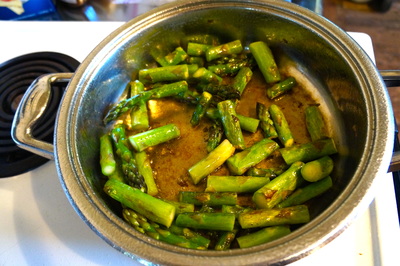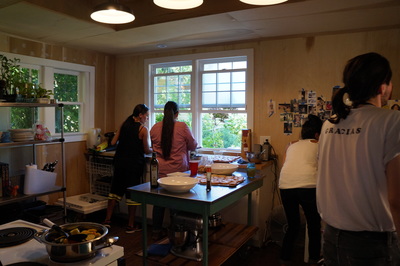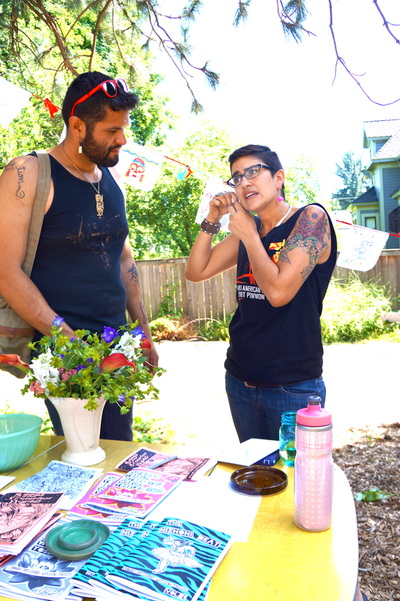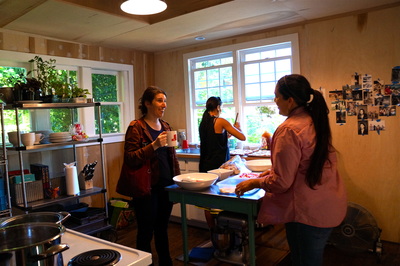One Flaming Arrow: Inter-Tribal Art, Music, and Film Festival
Natalie Ball, Shilo George, & Brittany Britton Visual Art Installation at Surplus Space Opening
June 4th 2015 6 - 9pm
Poetry Reading and Performance at Surplus Space!
June 6th 2015 2 - 5pm
Artist Panel Discussion and Exhibit Closing
June 13th noon - 2pm
One Flaming Arrow is an Inter-tribal, Indigenous Art, Music & Film festival happening from June 2nd-14th of 2015 in various venues throughout Portland, Oregon. One Flaming Arrowemerged as a collaboration between local business entrepreneur, Carlee Smith and the artist collective RISE: Radical, Indigenous, Survivance, & Empowerment’s Demian DinéYazhí (Diné) and Kaila Farrell-Smith (Klamath-Modoc). In autumn 2014 the One Flaming Arrowcollaborative came together through a collective desire to bring a platform for contemporary Indigenous art to the inter-tribal urban-Native communities of the Portland area and the project was selected as a 2014 Precipice Fund Grant awardee from Portland Institute of Contemporary Art with support from the Callagram Foundation and the Andy Warhol Foundation for the Visual Arts. One Flaming Arrow’s aim is to inspire the rural, reservation, and urban Indigenous communities: Chinook, Multnomah, Warm Springs, Yakima, Grand Ronde, Klamath, Modoc, Coos, Coquille, through interactive, intellectually stimulating examples of Survivance via-contemporary arts.
One Flaming Arrow's goal is to promote, empower, educate, persevere, and heal through the creative and political act of contemporary Indigenous Survivance. One Flaming Arrowaccomplishes its goals by bringing emerging, experimental, and established contemporary artists showing within museums to experimental art exhibitions on reclaimed Indigenous land. RISE has carefully curated this inaugural festival to bring exposure and create a platform of what contemporary Indigenous art forms can look, move, and sound like. Inspiring, motivating and building strong representation for Native youth and emerging Indigenous artists to be exposed to.
One Flaming Arrow's goal is to promote, empower, educate, persevere, and heal through the creative and political act of contemporary Indigenous Survivance. One Flaming Arrowaccomplishes its goals by bringing emerging, experimental, and established contemporary artists showing within museums to experimental art exhibitions on reclaimed Indigenous land. RISE has carefully curated this inaugural festival to bring exposure and create a platform of what contemporary Indigenous art forms can look, move, and sound like. Inspiring, motivating and building strong representation for Native youth and emerging Indigenous artists to be exposed to.
INSTALLATIONS
Natalie Ball
White box
Kitchen
Natalie Ball (Modoc-Klamath) is a multi-media visual artist based in Chiloquin, Oregon. Her work examines the internal and external discourses that shape Indian identity through contemporary installation art. Her artistic practice is based in dissecting historical discourses of Native Americans, which have constructed a limited and inconsistent visual archive that currently misrepresents past experiences and misinforms current expectations. Natalie Ball excavates hidden histories and dominant narratives, artistically deconstructing via a theoretical framework of auto-ethnography to move “Indian” outside of governing discourses in order to rebuild a new visual genealogy in refusal to line-up with the many constructed existences of Native Americans. Her solo exhibition titled ‘Mapping Coyote Black’ is currently at the Nerman Museum in the Oppenheimer New Media Gallery in Overland Park, Kansas. Natalie Ball received her MMVA (Masters in Maori Visual Arts) from Massey University in 2009.
nataliemball.com
nataliemball.com
Brittany Britton
Parlor
Brittany Britton (Hupa) is a Portland based artist. At the core, the work is a means for the artist to come in and take ownership of identities as a queer native woman by finding symbols and objects from her cultures that create power and authenticity. The overlap of these identities make hazy spaces that are not easily searched, and need new language to describe them. Brittany's investigations make use of drag as a tool to co-opt symbols and objects from dominant narratives and place herself in positions that might not be afforded. Current intersections concern masculinity as a space of power and demonstrating what queerness and indigeneity could look like across the spectrum of gender expression.
brittanybritton.com
brittanybritton.com
Shilo George
Shilo George (Southern Cheyenne-Arapaho) is a Portland based artist, showcasing herFat Femme Warrior Regalia installation at Surplus Space for the duration of the festival. "By living in a body that transgresses and violates Western standards of beauty, size, sexuality, health, and gender expression, I come across daily oppressive institutional forces as well as micro and macro aggressions from people around me. I walk through my day as a warrior battling to take up the space I need, be seen and treated with respect, and to move beyond simply living and intosurvivance. The Fat Femme Warrior Regaliaproject has come out of the desire to create a physical/visual representation of the psychological, psychic, and spiritual ways that I protect myself as a superfat, queer femme, modern-day, urban Cheyenne warrior navigating this 21st century post-apocalyptic Turtle Island."
Rochelle Kulei
Rez Kitchen - Opening Night - Elk Stew and Fry Bread
Rochelle Kulei is an Urban Shoshone Indian who walks in a hazy borderland between her Native world and the modern world. Kulei struggles to live in both worlds, trying to balance each one in my life. Her work focuses on the importance of living in the past, present, and future, which is intertwined with the sacred wheel. It is essential for her to connect with her culture so that she may understand her identity as a Shoshone Indian living in a Contemporary world. By connecting with her culture it provides a power of self, family, and Native community. Mary Beth Faimon, a professor in social work and director of social work field education at Southwest Minnesota State University stated that when victims of the oppressors confront the traumatic events that took place in their lives “it demands a social action to bear witness to self-determination and cultural assertions to tell the truth about a forgotten history.”
There is an aspect of Kulei's art practice that embraces the current field of social practice, for example: gathering as community, collecting stories, working collaboratively. This of course is not a new practice, but an ancient one and a common way of passing on cultural stories, history, and current events. Before written language, books, and the Internet, there was a coming together of community and a sharing of information.
rochellekulei.com
There is an aspect of Kulei's art practice that embraces the current field of social practice, for example: gathering as community, collecting stories, working collaboratively. This of course is not a new practice, but an ancient one and a common way of passing on cultural stories, history, and current events. Before written language, books, and the Internet, there was a coming together of community and a sharing of information.
rochellekulei.com
Opening Night
BRAVE WOMEN RUN IN OUR FAMILIES
June 6th, 2015
Miranda Crystal
Miranda (CSKT/Blackfeet)is singer/songwriter from the Flathead Indian Reservation in Northern MT. She holds a Master's Degree in Native American Studies, Education, and Film. Her recent publication based on research done on the Flathead Indian Reservation in Northwest MT and in Chiapas, Mexico, "Planting the Seeds of Change of Educational Change; Indigenous Voices, Multicultural Education, and the US Democratic Ideal", can be found in "Nationalisms and Identities among Indigenous Peoples". Her musical style can be described as soul/blues/jazz fusion. Recognizing education and music as a powerful catalysts through which social change can occur she plans to study Ethnomusicology in the near future, focusing on the role of music in healing among Indigenous peoples and communities across the globe.
Amanda Ranth
|
Amanda Ranth1 from Surplus Space on Vimeo. |
Amanda Ranth (Shoshone-Bannock) is a poet and performance artist inspired by performance work that straddles music and poetry like Joy Harjo as well as artists who invoke story telling through both ancient and modern imagery such as Naomi Shihab Nye. Amanda's was raised in Idaho and currently resides in New Mexico, where she was a part of several community theater projects that varied from street improv to black box. Amanda's work orbits the themes of vulnerability and resilience, exploring curiosity about seeds, cosmic patterns, radical politics, the human body and love. She is aims to take a vivid look at genocide and oppression as a means of healing our culture's painful history. Amanda Ranth is dedicated to collaborating with artists who work to expose and involve their communities in art making.
Melanie Fey
Melanie Fey is a Diné (Navajo), German and Italian zinester, writer/activist and Indigenous feminist. She’s one of the co-editors/founders of the Native American feminist zine Empower Yoself Before You Wreck Yoself and has contributed to other zines such as From Hell to High Water, Survivance: Indigenous Poesis, and Stories From Oyate: Modern Native American Voices. She was born in Tuba City Dinétah, grew up in the reservation border town of Flagstaff, AZ and received her Bachelor of Arts in Creative Writing from Arizona State University. After her graduation, she lived briefly in Fukuoka, Japan and currently resides in Portland, Oregon working as a public library book nerd. Her work seeks to celebrate the two spirit/LGBTQ community, raise awareness about violence against Native women and explore the sometimes conflicting dichotomy of rural and urban Native life.


